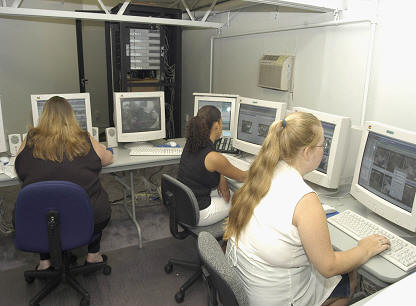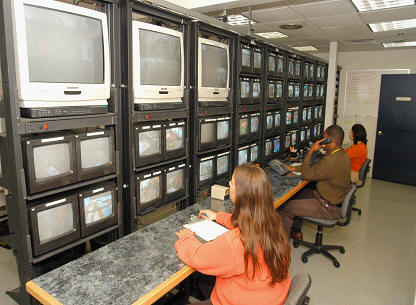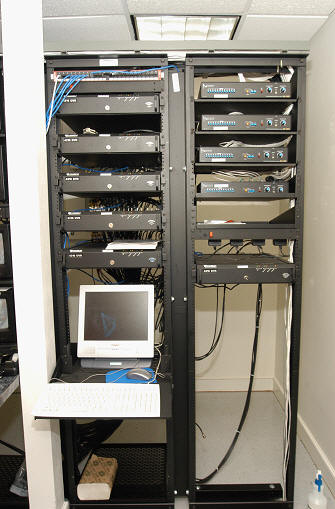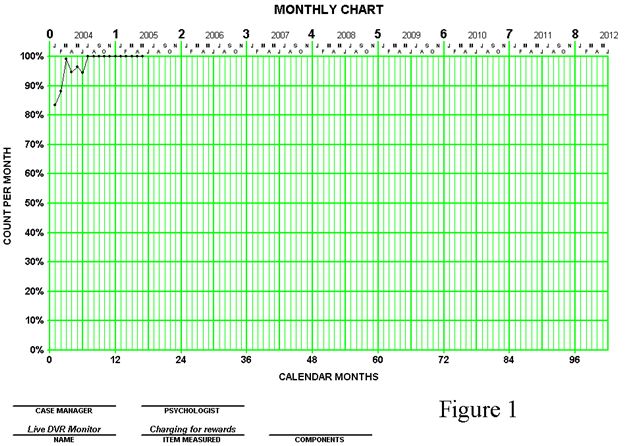
|
Use of Skin-Shock at the Judge Rotenberg Educational Center (JRC) |
The Development of a Digital Video Recording System Allowing Real Time
Monitoring of
40 Residences Spread Throughout Southern Massachusetts Across the Internet
Robert E. von Heyn, Ed Langford, Kerry Krause and Maryellen Kelley
Judge Rotenberg Center Canton MA USA
The Judge Rotenberg Educational Center operates day and residential programs for children and adults with behavior problems, including conduct disorders, emotional problems, brain injury or psychosis, autism and developmental disabilities. The basic approach taken at JRC is the use of behavioral psychology and its various technological applications, such as behavioral education, programmed instruction, precision teaching, behavior modification, behavior therapy, behavioral counseling, self-management of behavior and chart-sharing. In order to improve on the consistent implementation of the behavioral treatment a Digital Video Recording system was developed that allowed for real time viewing of all residences from one central location. With this new technology staff and client behavior were closely monitored and near instant feedback was provided to the direct care staff. In addition, video clips could be retrieved for up to two weeks prior to allow for the functional assessment of problematic behavior and useful as a staff training tool to view proper and improper implementation of treatment plans.
Introduction
Residential treatment programs face the challenge of ensuring consistent behavioral treatment across treatment settings. This is especially true of programs that have separate day and residential settings. If behavioral programs are successfully implemented in one setting but not the other then the overall effectiveness of the treatment is lessened. While it is relatively easy for administrative staff to monitor behavioral treatment programs during the day, it is generally not feasible to have administrative staff monitoring programs during the evening and overnight hours.
At JRC, cameras and VCRs were used previously to record the hours when clients were in each residence and the tapes were brought into the main school building each morning. The JRC video monitoring staff would review specific incidences and try to spot check the 19 residential settings. However staff could only observe limited amounts of tape due to the vast number of hours recorded. In addition, much data were lost due to mechanical failures of both the VCRs and tapes. Our interest in digital recording began at the ABA Conference in New Orleans in 2001 at an exhibitor’s booth. Following months of research it was decided to invest in a Digital Video Recording (DVR) system. While the initial setup costs were high, compared to the VCR system, the DVR system is relatively maintenance free.
Method
Participants and Apparatus
All 240 clients and nearly 900 staff were digitally recorded. The DVRs were purchased from March Networks and connected to color cameras. Each DVR was connected to the internet via a high speed cable connection. The primary cameras used were Panasonic WV-CP244. The cameras in the vans were 12 volt DC from Welddex connected to a modem from Bluetree, Model number BT-1110 CDMA/1XRTT/GPS.
Procedure
Currently 44 residences were equipped with a DVR system that is capable of recording all rooms. At the main school building, 10 DVR systems were located and received input from 58 cameras located in all rooms and areas that clients were located, including outside the school building. In addition, 27 vans and buses, used to transport the clients, were equipped with DVR systems. Some of the systems recorded the behaviors of the occupants on a hard drive and others were connected to the internet through a wireless modem. Some of the DVRs in the vans were GPS enabled allowing monitoring staff to find them on a map and also visually see their surroundings.
All of the DVRs in the school building were directly connected to 55 monitors located in an office where staff monitored all camera angles. The monitors were capable of 73 different views and JRC monitoring staff and quality control personnel staff were always present when clients were in the building. The residential cameras, besides going to the DVR, were also connected to a monitor in the residence that was capable of displaying up to 16 views. This allowed one staff to monitor the entire residence from one location. Whenever clients were in a residence, staff located in our main building, were able to view each room. During the overnight hours there were always two staff present in our main building and they used 7 computer monitors, capable of viewing input from 16 different cameras. This allowed for live monitoring of each residence. Finally all camera views, residences, vans and school are available for administrative staff to view live or archived recordings.
JRC has developed various checklists for DVR monitoring staff to use to evaluate staff as they carry out their responsibilities. An example checklist is presented in Table 1 and lists staff behaviors that the monitoring staff were instructed to evaluate. For example, monitoring staff may count the number of times the staff correctly use the token economy and charge students for their rewards. These data are then summarized and plotted on a chart that depicts the percentage of time staff act correctly.
Results and Summary
The DVR system installed throughout JRC has enabled real time monitoring across all settings. This system allowed our most experienced staff to be present, in essence, in all locations that clients were located and offer immediate feedback on how to more effectively administer each client’s behavior modification treatment program. The use of the DVR Monitoring Checklist allowed JRC to quantify the integrity of each behavioral treatment program and identify problem areas. Figure 1 depicts a good example of a problem identified, added to a monitoring checklist, and corrected. It was observed in January 2004 that some staff were not properly using the token economy system. Monitoring staff were instructed to look closely at the staff’s use of this system and to provide verbal and written feedback. Initially the system was used correctly in only 84% of the observations but, after 6 months, had risen to 100%.
In addition, clinicians and other administrative staff were able to view both live segments from every camera as well as archived video for the prior two weeks. With this ability a functional assessment was possible across all environmental settings and antecedents to problematic behaviors identified.




| Classrooms Monitored: | ||||||
| Supervisors initials. | ||||||
| SHIFT TALLIED TOTALS FROM PACKETS COMPLETED. | SHIFT TALLIED TOTALS FROM PACKETS COMPLETED. | |||||
| Targeted Deviations | Total # correct | Total # in-correct. | Targeted Deviations | Total # correct | Total # in-correct. | |
| Teachers are behind their desks b/w 9 - 10am and 2-3pm/3-4pm only. (2-3pm and 4-4pm for teachers sched to 3 and 4pm respectively) | ||||||
| Staff gives casual AC | Staff are present in the GM Area of the classroom - not behind teacher's desk | |||||
| Students rewarded based on their recording sheets. | Following 1:1 procedure | |||||
| Following students' rules | Following schedule | |||||
| Electrode rotation policy being followed @ top of hour | Setting/going over students contracts | |||||
| Inappropriate interaction/conversation with students | Following the Lanyard system | |||||
| Tokens given at timer | Following students programs | |||||
| Poor body positioning | Having reminder timer set | |||||
| Leaving students unattended | Going over LTDKs and SPCKs | |||||
| GED verification procedure being followed | Pinpointing behaviors, including using correct DC procedures | |||||
| Poor supervision of students | Following LOP procedures | |||||
| Poor use of JRC time/staff doing nothing | Fine for inappropriate behaviors | |||||
| Recording behavior frequency | Charging for rewards | |||||
| GED transmitter with student's staff | Students engaged in appropriate activities | |||||
| Performance Credit | Perf. Improvement | |||||
| Please list any noticed performance pinpoints not listed on this checklist you think should be added to the checklist. | ||||||
| Additional Shift Notes | ||||||